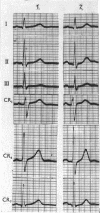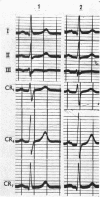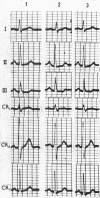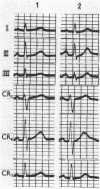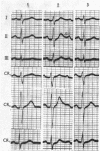Full text
PDF










Images in this article
Selected References
These references are in PubMed. This may not be the complete list of references from this article.
- ACHESON E. D. The electrocardiogram after exercise in the detection of latent coronary-artery disease in R.A.F. personnel. Lancet. 1957 Jan 5;272(6958):26–27. doi: 10.1016/s0140-6736(57)92440-6. [DOI] [PubMed] [Google Scholar]
- Biorck G. HYPOXAEMIA TESTS IN CORONARY DISEASE. Br Heart J. 1946 Jan;8(1):17–24. [PMC free article] [PubMed] [Google Scholar]
- CHELTON L. G., BURCHELL H. B. Unusual RT segment deviations in electrocardiograms of normal persons. Am J Med Sci. 1955 Jul;230(1):54–60. doi: 10.1097/00000441-195507000-00008. [DOI] [PubMed] [Google Scholar]
- EVANS W., MCRAE C. The lesser electrocardiographic signs of cardiac pain. Br Heart J. 1952 Oct;14(4):429–441. doi: 10.1136/hrt.14.4.429. [DOI] [PMC free article] [PubMed] [Google Scholar]
- EVANS W., PILLAY R. K. Additional electrocardiographic signs of cardiac pain. Br Heart J. 1957 Jul;19(3):366–374. doi: 10.1136/hrt.19.3.366. [DOI] [PMC free article] [PubMed] [Google Scholar]
- EVANS W. The effect of deep inbreathing on lead III of the electrocardiogram. Br Heart J. 1951 Oct;13(4):457–466. doi: 10.1136/hrt.13.4.457. [DOI] [PMC free article] [PubMed] [Google Scholar]
- MANNING G. W. The electrocardiogram of the 2-step exercise stress test. Am Heart J. 1957 Dec;54(6):823–836. doi: 10.1016/0002-8703(57)90188-6. [DOI] [PubMed] [Google Scholar]
- MASTER A. M., FIELD L. E., DONOSO E. Coronary artery disease and the two-step exercise test. N Y State J Med. 1957 Mar 15;57(6):1051–1061. [PubMed] [Google Scholar]
- MASTER A. M. The two-step exercise electrocardiogram: a test for coronary insufficiency. Ann Intern Med. 1950 May;32(5):842–863. doi: 10.7326/0003-4819-32-5-842. [DOI] [PubMed] [Google Scholar]
- PALMER J. H. U wave inversion. Br Heart J. 1948 Oct;10(4):247–251. doi: 10.1136/hrt.10.4.247. [DOI] [PMC free article] [PubMed] [Google Scholar]
- ROBB G. P., MARKS H. H., MATTINGLY T. W. The value of the double standard two-step exercise test in the detection of coronary disease; a clinical and statistical follow-up study of military personnel and insurance applicants. Trans Assoc Life Insur Med Dir Am. 1956;40:52-80; discussion, 80-5. [PubMed] [Google Scholar]
- ROSEN I. L., GARDBERG M. The effects of nonpathologic factors on the electrocardiogram. I. Results of observations under controlled conditions. Am Heart J. 1957 Apr;53(4):494–504. doi: 10.1016/0002-8703(57)90358-7. [DOI] [PubMed] [Google Scholar]
- SCHERF D., SCHAFFER A. I. The electrocardiographic exercise test. Am Heart J. 1952 Jun;43(6):927–946. doi: 10.1016/0002-8703(52)90250-0. [DOI] [PubMed] [Google Scholar]
- WOOD P., McGREGOR M., MAGIDSON O., WHITTAKER W. The effort test in angina pectoris. Br Heart J. 1950 Oct;12(4):363–371. doi: 10.1136/hrt.12.4.363. [DOI] [PMC free article] [PubMed] [Google Scholar]
- YU P. N. G., BRUCE R. A., LOVEJOY F. W., Jr, McDOWELL M. E. Variations in electrocardiographic responses during exercise; studies of normal subjects under unusual stresses and of patients with cardiopulmonary diseases. Circulation. 1951 Mar;3(3):368–376. doi: 10.1161/01.cir.3.3.368. [DOI] [PubMed] [Google Scholar]






